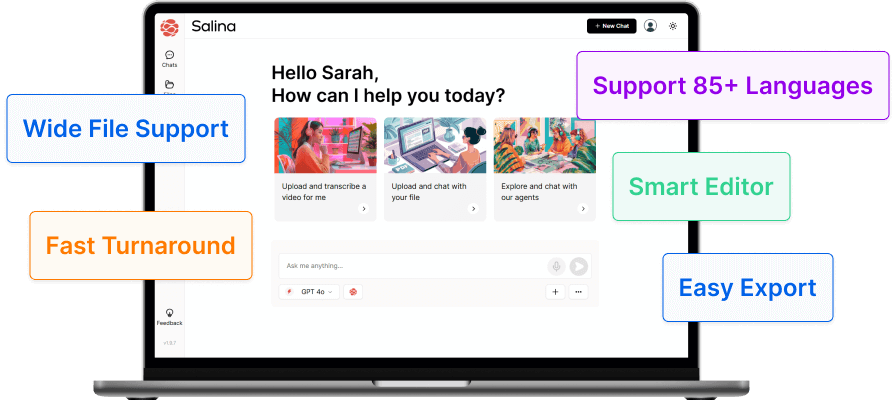Some podcasts keep you listening, while others just become background noise. What’s the difference? Often, it’s a good script. A well-written podcast script can make your show stand out and keep people coming back for more.
This guide will show you how to write podcast scripts that grab attention and turn casual listeners into big fans. Whether you’re new to podcasting or want to make your show better, these tips will help you create episodes that people love to hear.
In a rush? Here are the key questions this guide answers:
- How can I start my podcast with a strong hook?
- What’s the best way to structure my podcast script?
- How can I use sensory details to make my podcast more engaging?
- How do I write in a conversational tone for my podcast?
- How can I save time on podcast scripting?
The Invisible Architecture of Podcast Scripting
Many think scripting a podcast kills its natural feel. But here’s a surprise: the most spontaneous-sounding shows often have a secret – a well-planned script. This hidden structure isn’t about reading word-for-word. It’s about creating a flexible plan that guides your show while letting your personality shine.
In my effort to learn more about podcast scripting, I recently came across an informative discussion on the topic.
It was interesting to see the variety of approaches different creators use. Some podcasters prefer fully scripted content for accuracy, while others use bullet points or outlines to keep things conversational. What stood out was advice from an experienced podcaster: “Do NOT trust anyone who says one way of doing a show is better than the other”. This reinforced the idea that effective scripting is about finding what works best for your unique style and content, rather than following a one-size-fits-all approach. The goal, regardless of the method, is to sound natural and engaging to listeners.
Podcast scripting is like setting up a blueprint for great conversations. It helps you stay on track and deliver value in every episode, but still leaves room for unplanned moments. Good scripting is like having a map for a road trip – you know where you’re going, but you can still take fun detours.
This approach focuses on more than just words. It’s about planning key moments, knowing when to pause, and moving smoothly between topics. It gives your podcast a clear direction while keeping things engaging for listeners.
We’ll now explore how to build this invisible framework for your podcast, turning your show from a casual chat into a must-listen experience that keeps people coming back. These scripting tips can help you transform occasional listeners into loyal fans.
Building Your Podcast Script: A Step-by-Step Guide
1. Start Strong: Hook Your Listeners Right Away
Starting your podcast with a strong hook is key to grabbing your listeners’ attention. Think about what would make you curious if you were the listener. Your introduction sets the tone for the entire episode, so it’s worth spending extra time to get it right.
Tim Ferriss, a renowned entrepreneur, best-selling author, and host of The Tim Ferriss Show—one of the most downloaded podcasts in the world—emphasizes the importance of a strong opening:
“The first 30 seconds of your podcast are critical. Use a hook that immediately piques curiosity or presents a problem your audience wants solved.
For more insights on effective podcast scripting, check out this episode of The Tim Ferriss Show featuring Neil Gaiman:
If you’re scripting for a podcast on cooking, you could start with something like this:
“You open your fridge to find just five ingredients staring back at you. In 20 minutes, those same ingredients could become a restaurant-quality meal that will impress anyone at your table. Let’s dive into how you can make it happen.”
This works because it immediately places the listener in a relatable situation and promises a solution to a common challenge. It sparks curiosity and gives them a reason to keep listening.
Finally, remember that your introduction should briefly outline what the episode will cover. This roadmap helps listeners understand what to expect and decide if the content is relevant to them. Keep it concise but informative to set the stage for an engaging episode.
2. Structure Your Podcast Script for Clarity and Flow
Good storytelling keeps your listeners engaged throughout your podcast. Think of your episode as a story with a beginning, middle, and end. This structure helps your audience follow along and stay interested from start to finish.
A great example of this approach comes from Pat Flynn, host of The Smart Passive Income Podcast. Flynn’s podcast focuses on actionable advice for entrepreneurs, and his episodes follow a clear framework:
- Intro: Hook and episode preview
- Main Content: 3-5 clear sections
- Transitions: Smoothly connect ideas
- Recap: Highlight key takeaways
- Call-to-Action: End with a clear next step
To gain more insights into effective podcast scripting and structure, check out Pat Flynn’s Smart Passive Income Podcast here:
While this structure provides a solid foundation, different podcast formats may require unique approaches. For example, interview-based podcasts often include scripts for guest introductions, prepared questions, and transitions while allowing room for natural conversation. Narrative-driven shows, like true crime or storytelling podcasts, rely on detailed scripts with voiceovers, sound effects, and precise timing cues for editors.
Panel discussions or roundtable podcasts also require careful planning to manage multiple speakers and ensure smooth transitions between voices. These variables—such as having guests, managing multiple speakers, or incorporating sound design—highlight how scripting can adapt to fit the style and goals of your podcast.
In our next blog post, we’ll explore these advanced scripting formats in greater detail and share tips for tailoring them to fit different podcast styles and goals.
3. Weave Sensory Details into Your Script
Adding sensory details to your podcast script can make your show more engaging. These details help listeners imagine what you’re describing and feel more connected to your content. While many podcasters focus on facts, using descriptions that appeal to the senses can make your episodes more memorable.
For example, instead of saying, “It was a cold morning,” try “The frost clung to the windows, and you could see your breath in the air.” If you’re doing a cooking podcast, describe the sizzle of onions in a pan or the smell of fresh bread. These small touches bring your words to life and draw listeners into your world.
Sensory details can also set the mood. For a suspenseful story, mention creaky floorboards or flickering lights. For a relaxation podcast, use words like “gentle waves” or “soft rustling leaves” to create a calm atmosphere.
Check out this recent LinkedIn post by Lyndsay Phillips, a podcast expert:
Phillips shares valuable tips that many podcasters overlook. Her advice on engaging the senses can help transform your podcast from a simple conversation into an immersive experience for your listeners.
By using sensory details in your script, you’re helping listeners feel like they’re part of the story. It’s an easy way to make your episodes more interesting and keep people coming back for more.
4. Write Like You’re Talking to One Listener
When writing your script, imagine you’re talking to a friend. Use a conversational tone to sound natural and approachable. This doesn’t mean being overly casual or using slang, but rather finding a balance between informative and friendly.
Podcast expert Nic Redman emphasizes the importance of authenticity:
“Write as you speak – use contractions, slang, and informal language. Your listeners will appreciate the authenticity and feel like they’re having a conversation with you.”
For more insights on writing conversational podcast scripts, check out Nic’s blog post:
Additionally here are some techniques to keep your audience engaged:
- Use “you” and “your” to speak directly to the listener.
- Ask rhetorical questions to make the listener think.
- Share personal anecdotes to illustrate your points.
- Use analogies to explain complex ideas.
- Vary your sentence length to create a natural rhythm.
Consider adding interactive segments to your podcast. Include segments that encourage listener interaction, such as Q&A sessions or listener stories. This transforms passive listeners into active participants, deepening their connection to your podcast.
You could ask listeners to submit questions via social media, share their own experiences related to the topic, or participate in polls. This not only engages your audience but also provides valuable content for future episodes.
5. Add Flexibility and Personality to Your Script
Your podcast script isn’t just about what you say. It’s also about how you say it and how it connects with your audience. Adding flexibility and personality into your script helps ensure that every episode feels fresh, authentic, and engaging. Whether it’s leaving room for spontaneous moments or crafting CTAs that inspire action, these small adjustments can make a big difference in how listeners experience your show.
Leave Room for Spontaneity
While having a script is important, allow for some flexibility to keep your podcast sounding fresh and authentic. This might mean leaving blank spaces in your script for improvisation or marking sections where you can expand on a point if time allows. The goal is to find a balance between structure and flexibility.
A recent Reddit discussion highlighted the varied approaches podcasters take to scripting.
Some prefer fully scripted content for accuracy and conciseness, while others use bullet points or outlines to maintain a more conversational style. One podcaster shared, “I just script out the entire thing, but sometimes, I do go off script when, for instance, I have a scene where I get mad about something and I think of something funny to add in the moment”.
Use Delivery Notes
To make your podcast script more dynamic and engaging, add delivery notes about pauses, emphasis, or tone changes. These notes help bring your content to life when recording.
For example: “But here’s the thing (pause for effect)… not all podcast scripts are created equal. (Emphasize) The best ones are like a roadmap, guiding you through your content while still leaving room for those magical unscripted moments.” Use annotations to indicate tone, underlining for emphasis, pauses for effect, and pronunciation guides for tricky words. These elements add life to your script and help maintain listener engagement throughout the episode.
Craft Compelling Calls-to-Action
While CTAs were briefly mentioned in number two as part of structuring your script, they’re worth exploring further here because of their important role in engaging your audience beyond the episode itself. A strong CTA doesn’t just end an episode—it creates a bridge between your content and the actions you want listeners to take.
End each episode with a clear, actionable request for your listeners. Make it simple and specific, like subscribing to your podcast or joining a discussion on social media. Your CTA should be relevant to the episode content and provide value to your listeners. Keep it short and create a sense of urgency to encourage quick action.
For example, instead of saying “We’re giving away bumper stickers to anyone who takes our survey,” say “The first ten people to take our survey get a free bumper sticker.” This makes listeners more likely to respond quickly.
Be clear about what you want them to do, why, and how. Put the benefit for the listener up front so they don’t have to ask “What’s in it for me?” Consider including additional information or resources in your show notes using a short, trackable link to measure the impact of your CTA.
6. Refine Your Script with Real-Time Adjustments and Listener Insights
Creating a great podcast script goes beyond writing. It involves practicing, making adjustments as you go, and learning from your audience to make each episode better. By treating your script as a flexible tool, you can adapt it to meet the needs of your listeners while staying true to your voice.
Practice and Refine as You Go
Before recording, read your script aloud several times to catch awkward phrases and ensure everything flows naturally. Pay attention to how the words sound when spoken because they often feel different than they do on paper. Mark places where you naturally pause or emphasize certain words, and use these notes to guide your delivery during recording.
Recording practice runs can also be helpful. Listening back allows you to spot where energy dips or transitions feel clunky. Use this opportunity to rewrite sentences, rearrange sections, or cut anything that doesn’t add value. The goal is to make sure your script feels conversational and engaging when spoken aloud.
In a not so recent yet valuable episode of The Recognized Authority podcast, host Alastair McDermott interviewed John Lee Dumas, the renowned podcaster behind Entrepreneurs on Fire. During their conversation, Dumas shared valuable insights on creating successful podcast content, including the importance of continuous improvement.
John Lee Dumas, known for his daily podcast Entrepreneurs on Fire which has garnered over 1 million monthly downloads and featured guests like Tony Robbins and Tim Ferriss, emphasized the value of treating each episode as an experiment. In the interview, Dumas advised podcasters to consistently ask themselves after every episode:
“What worked? What didn’t?” This iterative approach, he explained, is crucial for refining content over time and delivering increasing value to listeners.
To hear more of John Lee Dumas’s insights on successful content creation, check out his full interview on The Recognized Authority podcast:
Use Listener Feedback for Your Scripts
Once your episodes are live, pay attention to what your audience is saying. Comments, reviews, and social media mentions can reveal what listeners enjoy most or where they lose interest. Analytics are also a powerful tool. Look at listener drop-off points or which episodes have the highest engagement to identify areas for improvement.
Directly involving your audience can also provide valuable insights. Use polls or Q&A sessions to ask what topics they’d like covered or which segments they enjoy most. This approach not only helps you create content that resonates but also strengthens your connection with listeners, making them feel like active participants in your podcast.
Keeping a “podcast journal” is another effective way to track progress. Use it to document what worked well in each episode, areas that could be improved, and recurring feedback from your audience. Over time, this journal becomes a practical resource for refining your scripting process and building on past successes.
Real-time adjustments during practice combined with listener insights help you create scripts that feel fresh, relevant, and engaging. Consistently delivering value while staying authentic behind the microphone will turn casual listeners into loyal fans and help you develop a scripting process that works for both you and your audience.
John Lee Dumas also emphasizes the importance of identifying your “big idea” and finding your “zone of fire” – the intersection of what you’re passionate about and where you can provide value. This concept can be applied to refining your podcast scripts, ensuring that each episode aligns with your core message and expertise.
Key Takeaways
- Start strong with a compelling hook to grab your audience’s attention immediately.
- Adapt your script to your podcast format to ensure it fits the style and flow of your show.
- Weave sensory details into your script to make your episodes more vivid and engaging.
- Write conversationally to connect with your audience on a personal level.
- Refine through practice and listener feedback to continuously improve your content and delivery.
What’s Next?
As podcasting continues to grow, creators are exploring new ways to make their scripts more engaging and accessible. Tools like transcription services and multilingual options are helping podcasters reach wider audiences, while real-time analytics are shaping how scripts are refined for better listener retention.
Looking ahead, the focus will shift toward creating even more interactive experiences. From live audience participation to AI-powered tools that suggest improvements, the future of podcast scripting is about making connections that feel personal and meaningful. Staying open to these changes will help podcasters craft content that resonates with listeners in fresh and exciting ways.
Save Time on Podcast Scripting with Salina
Even with the best strategies, crafting engaging podcast scripts regularly can be time-consuming. AI tools like Salina’s Podcast Script Generator can help streamline this process.
Salina’s Podcast Script Generator can quickly provide you with a range of content ideas, episode outlines, and even draft sections based on your podcast’s theme and topics. It’s a free feature that allows you to easily generate script ideas or request different content styles, such as informative, engaging, or story-driven.
Let Salina handle the initial script creation, so you can focus on personalizing the content and delivering a compelling podcast episode.
Podcast Script Generator FAQs
What is a Podcast Script Generator?
A Podcast Script Generator is an AI-powered tool designed to help podcasters create engaging and effective scripts for their episodes. It uses algorithms to generate content suggestions based on input about your podcast and episode topics.
How does a Podcast Script Generator work?
Users typically input information about their podcast, episode topics, or themes. The generator then processes this information and produces script outlines, talking points, and even draft sections using AI algorithms.
Are the scripts generated by AI unique?
While AI-generated scripts can be diverse and relevant, it’s important to review and customize them to ensure they perfectly fit your podcast’s voice and style. Always add your personal touch and ensure the content aligns with your unique approach.
Can a Podcast Script Generator improve my podcast’s quality?
Many Script Generators are designed to create engaging content that can potentially improve your podcast’s structure and flow. However, the effectiveness can vary, and it’s best to combine AI suggestions with your own expertise and understanding of your audience.
Is it better to use a Podcast Script Generator or create scripts manually?
A Podcast Script Generator can be a valuable tool for inspiration and efficiency, especially when you’re dealing with regular episode schedules. However, it’s often best to use it as a starting point and then refine the suggestions based on your unique understanding of your podcast and audience. Combining AI assistance with human creativity and personal touch often yields the best results.




